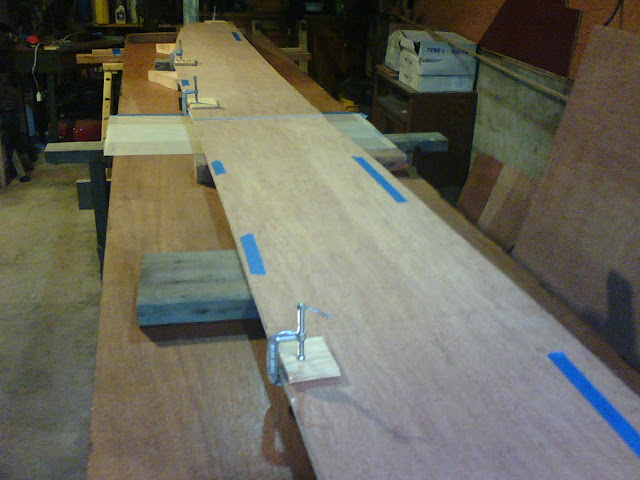 |
| side panel scarf |
To apply the glue I wet the wood on the scarf and I put the glue on the panels with a scraper/putty knife so as to keep the amount to a minimum and also to make sure that coverage was complete. A little glue oozed out and foamed up but not much and that was taken down with a chisel as a knife.
 |
| top: butt plate at scarf. bottom: front of panel after gluing. gap is just filled |
After cleaning up the excess glue I lined up the 2 side panels face to face to see how true a match I had. The tip of the bow and the tip of the stern lined up perfectly and most of the after panels were just right. The forward panels were slightly off in a few places and I am inclined to think that this was due to sloppy measurements and fat pencil lines, and sloppy cuts. I marked the places that needed fixing with tape and took a sureform to them until I had 2 matching sides. If the lines, the sheer and bottom are not fair at least the two sides will be symmetric.
 |
| The blue tape indicates places the 2 sides need to be trimmed to match. |
 |
| Transom as framing is added. |
I am cutting the frames for the stations from fir 2x4 scraps. I will fasten and glue them to the plywood panels. I am keeping station 10 and 4 as bulkheads so I will make those and the transom a bit different than stations 2 and 7. For fasteners I decided to try using brass wood screws. I am not sure how lasting they will be. I bought some stainless steel shake nails, that look like ring nails. I'm thinking of using these to fasten the bulkheads to the side panels.
 |
| brass pins used as clinch nail in test piece seemed to work alright. |
I also bought some brass brads or eschutcheon pins that I am thinking of using as clinch nails for a mechanical fastener on the side panel scarf. I am really ignorant to the cons of using brass.
I think I will have to take my time to get all the framing cut and applied to the stations. It is getting cold these days so that may slow me down as well. It is nice to have gotten something done, a step is a step.







